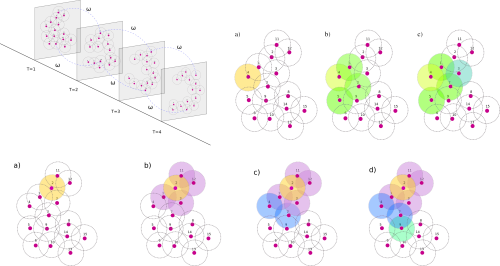An experimental approach to the consensus routing algorithm applied to temporal networks
Keywords:
temporal networks, consensus, complex systems, Routing algorithms, mobile distributed systemsAbstract
This article presents the implementation in real devices of the consensus-based routing algorithm (CRA). The CRA has the advantage of basing the route calculation on an availability function, considering the local conditions of a delimited neighborhood. This attribute allows the best candidate to be chosen to establish a connection within the temporary network.
Previously, simulations of the operation of the presented algorithm have been shown, this article shows its performance in a physical environment, using open hardware. In this way, real measures of communication latency between devices and task scheduling are considered. The characteristics as mentioned earlier make the CRA a good option to apply in temporal networks since they are present for brief moments, so they do not require the route to be two-way.
Downloads
References
P. Holme and J. Saramäki, “Temporal networks,” Physics reports, vol.519, no. 3, pp. 97–125, 2012.
S. H. Lee and P. Holme, “Navigating temporal networks,” Physica A: Statistical Mechanics and its Applications, vol. 513, pp. 288–296, 2019.
M. Li and H. Dankowicz, “Impact of temporal network structures on the speed of consensus formation in opinion dynamics,” Physica A:Statistical Mechanics and its Applications, vol. 523, pp. 1355–1370, 2019.
M. Arellano-Vázquez, “Estudio de sistemas adaptables de ruteo para sistemas distribuidos móviles,” Ph.D. dissertation, Posgrado en ciencia e ingenierı́a de la computación. Universidad Nacional Autónoma de México, 2015.
F. Aponte, M. Pineda, L. Gutierrez, I. Meriño, A. Salazar, and P. Wightman, “Cluster-based classification of blockchain consensus algorithms,”IEEE Latin America Transactions, vol. 100, no. 1e, 2020.
J. P. John, E. Katz-Bassett, A. Krishnamurthy, T. Anderson, and A. Venkataramani, “Consensus routing: The internet as a distributed system,” in Proceedings of the 5th USENIX Symposium on Networked Systems Design and Implementation, 2008, pp. 351–364.
A. Fagiolini and A. Bicchi, “On the robust synthesis of logical consensus algorithms for distributed intrusion detection,” Automatica, vol. 49, no. 8, pp. 2339–2350, 2013.
[A. Benchi, P. Launay, and F. Guidec, “Solving consensus in opportunistic networks,” in Proceedings of the 2015 International Conference on Distributed Computing and Networking, 2015, pp. 1–10.
A. Vahdat, D. Becker et al., “Epidemic routing for partially connected ad hoc networks,” 2000.
Y.-F. Hsu, C.-L. Hu, and H.-J. Hsiao, “On exploiting temporal period icity for message delivery in mobile opportunistic networks,” in 2018 IEEE 42nd Annual Computer Software and Applications Conference (COMPSAC), vol. 1. IEEE, 2018, pp. 809–810.
Y. O. Yazir, R. Farahbod, A. Guitouni, S. Ganti, and Y. Coady, “Adaptive routing in mobile ad hoc networks based on decision aid approach,” in Proceedings of the 8th ACM international workshop on Mobility management and wireless access, 2010, pp. 1–10.
P. Jacquet, P. Muhlethaler, T. Clausen, A. Laouiti, A. Qayyum, and L. Viennot, “Optimized link state routing protocol for ad hoc networks,” in Proceedings. IEEE International Multi Topic Conference, 2001. IEEE INMIC 2001. Technology for the 21st Century. IEEE, 2001, pp. 62–68.
D. B. Johnson and D. A. Maltz, “Dynamic source routing in ad hoc wireless networks,” in Mobile computing. Springer, 1996, pp. 153–181.
C. E. Perkins and E. M. Royer, “Ad-hoc on-demand distance vector routing,” in Proceedings WMCSA’99. Second IEEE Workshop on Mobile Computing Systems and Applications. IEEE, 1999, pp. 90–100.
K. Miyazaki, “First-come first-served routing for the data center network,” WTC2012, Mar., 2012.
E. Rojas, G. Ibañez, J. M. Gimenez-Guzman, J. A. Carral, A. Garcia-Martinez, I. Martinez-Yelmo, and J. M. Arco, “All-path bridging: Path exploration protocols for data center and campus networks,” Computer Networks, vol. 79, pp. 120–132, 2015.
B. Mao, Z. M. Fadlullah, F. Tang, N. Kato, O. Akashi, T. Inoue, and K. Mizutani, “Routing or computing? the paradigm shift towards intelligent computer network packet transmission based on deep learning,” IEEE Transactions on Computers, vol. 66, no. 11, pp. 1946–1960, 2017.
F. Tang, B. Mao, Z. M. Fadlullah, N. Kato, O. Akashi, T. Inoue, and K. Mizutani, “On removing routing protocol from future wireless networks: A real-time deep learning approach for intelligent traffic control,” IEEE Wireless Communications, vol. 25, no. 1, pp. 154–160, 2017.
F. Geyer and G. Carle, “Learning and generating distributed routing protocols using graph-based deep learning,” in Proceedings of the 2018 Workshop on Big Data Analytics and Machine Learning for Data Communication Networks, 2018, pp. 40–45.
T. Winter, P. Thubert, A. Brandt, J. W. Hui, R. Kelsey, P. Levis, K. Pister, R. Struik, J.-P. Vasseur, R. K. Alexander et al., “Rpl: Ipv6 routing protocol for low-power and lossy networks.” rfc, vol. 6550, pp. 1–157, 2012.
T. Clausen, J. Yi, and A. C. De Verdiere, “Loadng: Towards aodv version 2,” in 2012 IEEE Vehicular Technology Conference (VTC Fall). IEEE, 2012, pp. 1–5.
V. Nicosia, J. Tang, C. Mascolo, M. Musolesi, G. Russo, and V. Latora, “Graph metrics for temporal networks,” in Temporal networks. Springer, 2013, pp. 15–40.
L. E. Rocha and N. Masuda, “Random walk centrality for temporal networks,” New Journal of Physics, vol. 16, no. 6, p. 063023, 2014.
P. Holme, “Network reachability of real-world contact sequences,” Physical Review E, vol. 71, no. 4, p. 046119, 2005.
J. Macfarlane, Network routing basics: Understanding IP routing in Cisco systems. John Wiley & Sons, 2007.
M. Arellano-Vázquez, “Consensus routing algorithm,” https://github.com/magali-e/ConsensusRoutingAlgorithm, 2015.


